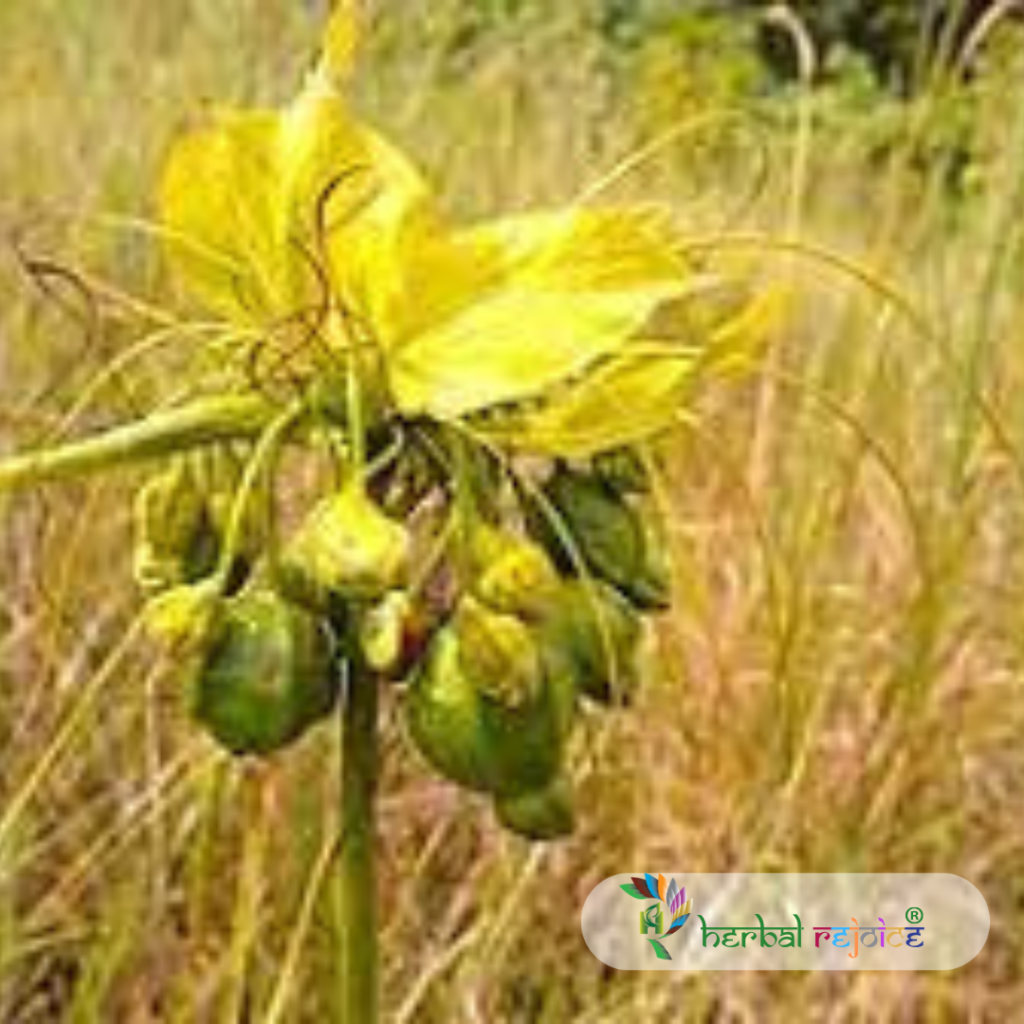Introduction
Fiji Arrowroot, also known as Tacca pinnatifida Forst. f. or T. leontopetaloides (Linn.) Kuntze, is a plant species that belongs to the Taccaceae family. It can be found throughout the Deccan Peninsula, including regions in Madhya Pradesh and Bihar. This plant is commonly referred to as Tahiti Arrowroot in English. In Ayurveda, it is known as Suurana, although the cultivated variety of elephant-foot yam, Amorphophallus paeoniifolius var. campanulatus, is used instead of the wild variety. In Siddha and Tamil traditional medicine, it is called Karachunai.
Medicinal properties
Fiji Arrowroot has various medicinal properties and is primarily used for its tuber, which possesses acrid, astringent, carminative, and anthelmintic properties. It is commonly used in the treatment of various ailments such as piles, haemophilic conditions, internal abscesses, colic, enlargement of the spleen, vomiting, asthma, bronchitis, elephantiasis, and intestinal worms.

Chemical Constituents
The tuber of Fiji Arrowroot contains approximately 76.0% starch, which can be extracted by macerating and repeatedly washing it with water. Additionally, the tuber has been found to contain beta-sitosterol, ceryl alcohol, and a bitter principle known as taccalin. The leaf extract of this plant has also been analyzed and found to contain taccagenin and leontogenin, which are isolated from an acid hydrolysate. Other compounds that have been isolated from Fiji Arrowroot include diosgenin and its derivatives, isonarthogenin, isonuatigenin, and nuatigenin.
Other Uses
A bitter extract can be prepared from the grated tubers of Fiji Arrowroot by washing them in running water. This extract not only acts as a rubefacient but is also used to treat diarrhoea and dysentery.
Conclusion
In conclusion, Fiji Arrowroot (Tacca pinnatifida) is used in traditional medicine for its acrid, astringent, and carminative properties. Its tuber helps treat piles, colic, and asthma, and contains starch, beta-sitosterol, and taccalin. Leaf extracts include taccagenin and leontogenin. In Ayurveda, it is often substituted with elephant-foot yam. The tuber can be used to prepare a bitter extract for treating diarrhoea and dysentery.
Frequently Asked Questions
What is Fiji Arrowroot?
Fiji Arrowroot, also known as Tacca pinnatifida Forst. f., is a plant species that is commonly referred to as Fiji Arrowroot or Tahiti Arrowroot in English.
What family does Fiji Arrowroot belong to?
Fiji Arrowroot belongs to the Taccaceae family.
Where can you find Fiji Arrowroot?
Fiji Arrowroot can be found throughout the Deccan Peninsula, including regions in Madhya Pradesh and Bihar.
What is the medicinal use of Fiji Arrowroot?
Fiji Arrowroot is primarily used for its tuber, which possesses acrid, astringent, carminative, and anthelmintic properties.
What ailments can Fiji Arrowroot treat?
Fiji Arrowroot is commonly used in the treatment of various ailments such as piles, haemophilic conditions, internal abscesses, colic, enlargement of the spleen, vomiting, asthma, bronchitis, elephantiasis, and intestinal worms.
What compounds are found in the tuber of Fiji Arrowroot?
The tuber of Fiji Arrowroot contains approximately 76.0% starch, beta-sitosterol, ceryl alcohol, and a bitter principle known as taccalin.
Are there any compounds found in the leaf extract of Fiji Arrowroot?
Yes, the leaf extract of Fiji Arrowroot contains taccagenin and leontogenin.
What other compounds have been isolated from Fiji Arrowroot?
Other compounds that have been isolated from Fiji Arrowroot include diosgenin and its derivatives, isonarthogenin, isonuatigenin, and nuatigenin.
Can a bitter extract be prepared from the grated tubers of Fiji Arrowroot?
Yes, a bitter extract can be prepared by washing the grated tubers of Fiji Arrowroot in running water.
What is the purpose of the bitter extract from Fiji Arrowroot?
The bitter extract from Fiji Arrowroot not only acts as a rubefacient but is also used to treat diarrhoea and dysentery.
What is the scientific name of Fiji Arrowroot?
The scientific name of Fiji Arrowroot is Tacca pinnatifida Forst. f.
What is the English name for Fiji Arrowroot?
The English name for Fiji Arrowroot is Tahiti Arrowroot.
Can the wild variety of the tuber be substituted with another variety in Ayurveda?
Yes, in Ayurveda, the wild variety of Fiji Arrowroot is often substituted with the cultivated variety of elephant-foot yam, Amorphophallus paeoniifolius var. campanulatus.
What is Fiji Arrowroot known as in Ayurveda?
In Ayurveda, Fiji Arrowroot is known as Suurana.
What is Fiji Arrowroot called in Siddha and Tamil traditional medicine?
In Siddha and Tamil traditional medicine, Fiji Arrowroot is called Karachunai.
What are the primary medicinal properties of Fiji Arrowroot?
The primary medicinal properties of Fiji Arrowroot are acrid, astringent, carminative, and anthelmintic.
Can Fiji Arrowroot be used to treat asthma and bronchitis?
Yes, Fiji Arrowroot is commonly used to treat asthma and bronchitis.
Is the tuber of Fiji Arrowroot the only part used for medicinal purposes?
No, the leaf extract of Fiji Arrowroot has also been found to have medicinal properties.
How is the starch extracted from the tuber of Fiji Arrowroot?
The starch can be extracted from the tuber by macerating and repeatedly washing it with water.
Are there any other traditional uses of Fiji Arrowroot?
Some traditional uses of Fiji Arrowroot include treating piles, haemophilic conditions, internal abscesses, colic, enlargement of the spleen, vomiting, and intestinal worms.


